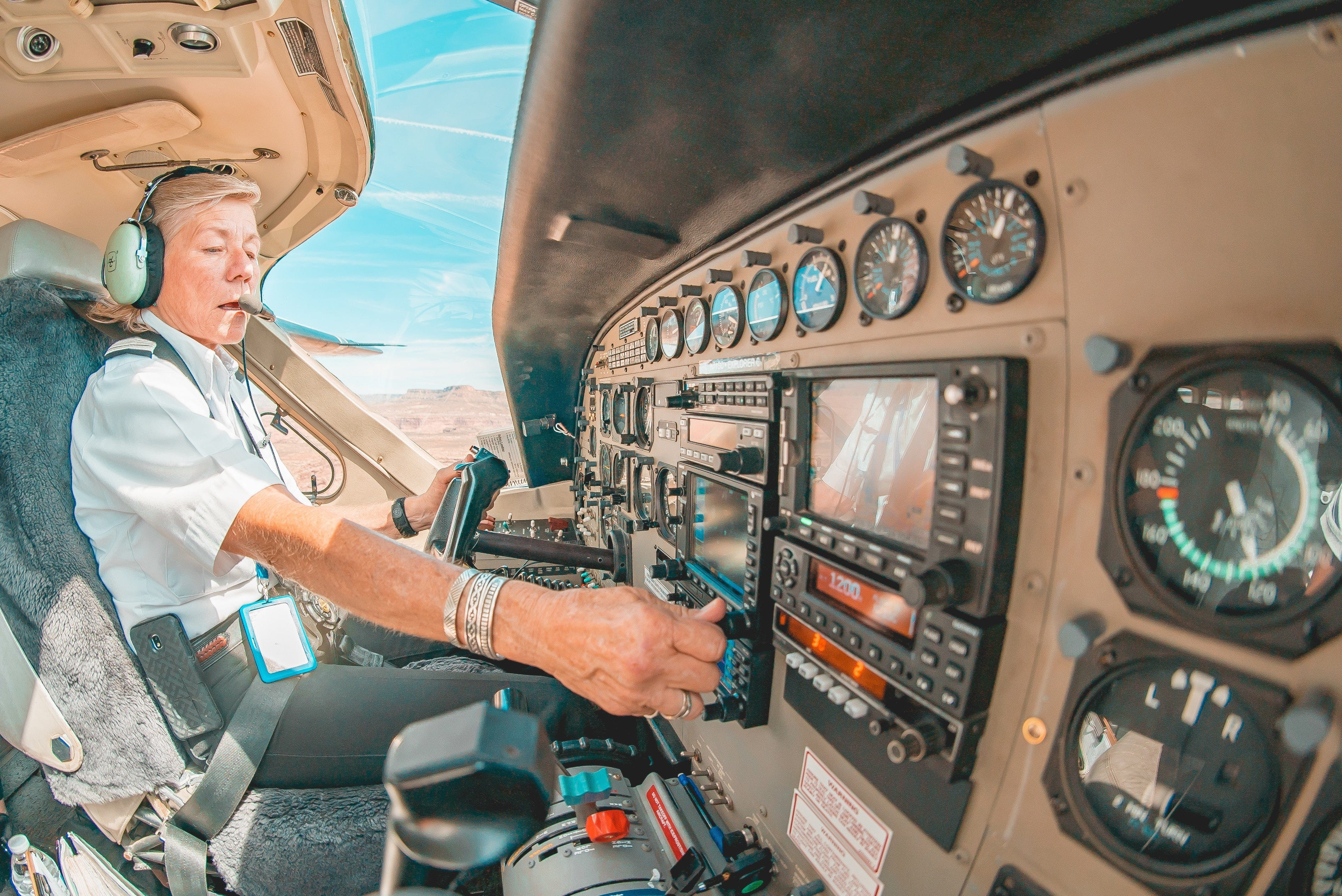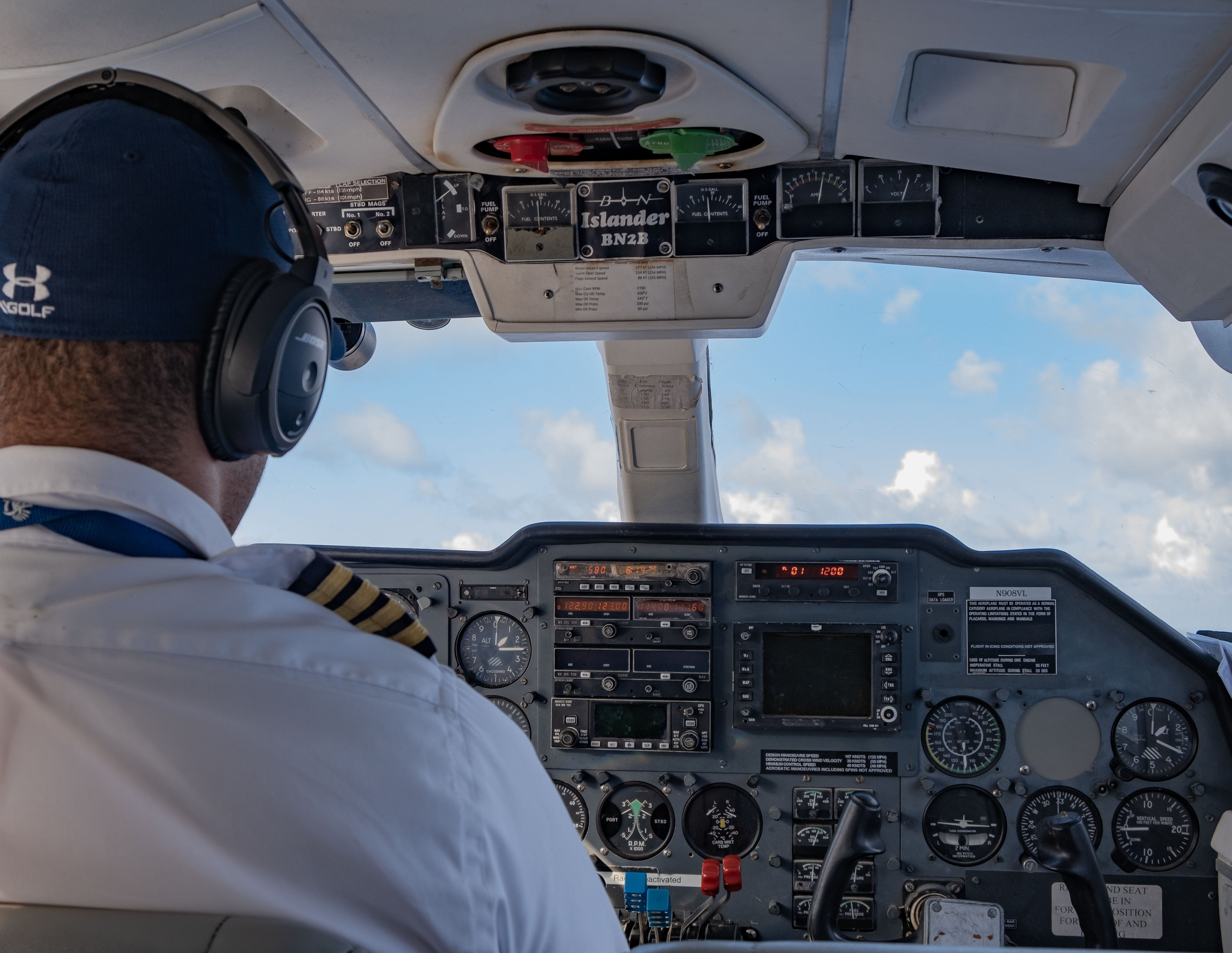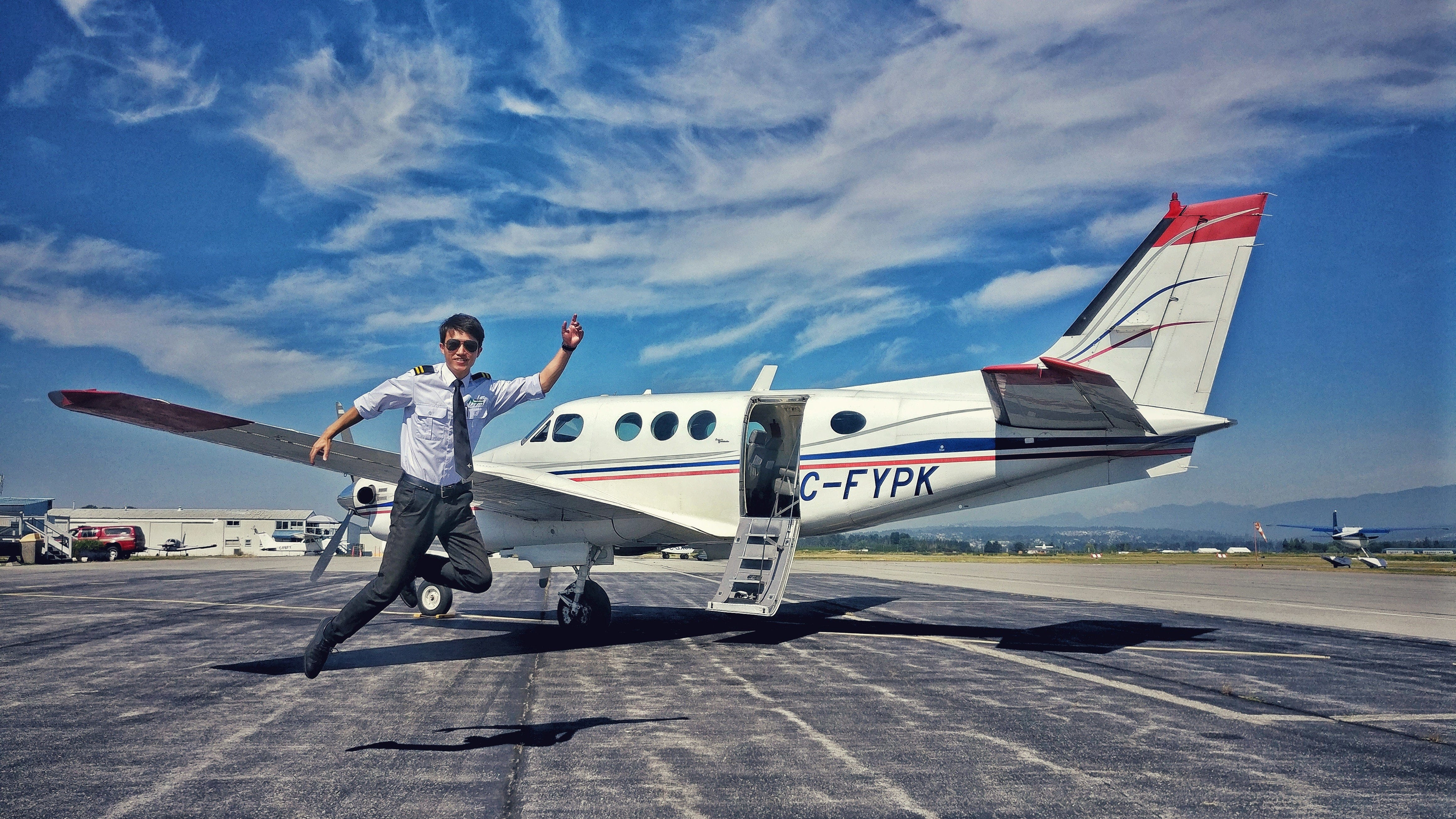Are you curious about how many hours a month a pilot can fly? Understanding pilot flight time regulations is crucial for anyone considering a career in aviation or those simply fascinated by the world of flight. At flyermedia.net, we break down the complex rules and regulations governing pilot work hours, ensuring you have a clear picture of what life in the cockpit truly entails. Discover the truth about pilot schedules, duty times, and how these factors impact their lives and careers, and learn about the resources available at flyermedia.net.
1. Understanding a Pilot’s Daily Routine
 A pilot preparing for a flight, showcasing the diverse tasks involved in their day
A pilot preparing for a flight, showcasing the diverse tasks involved in their day
A pilot’s day is far from monotonous. Photo by Westwind Air Service on Unsplash
What does a typical day look like for a pilot? The life of a pilot is dynamic, varying significantly from one day to the next. Unlike many jobs with fixed routines, pilots often encounter diverse schedules, flying to different cities and countries across multiple time zones. Some pilots manage numerous shorter flights in a single day, while others undertake fewer, longer flights that involve layovers.
1.1 The Typical Pilot’s Day
Upon arrival at the airport, pilots check in with their airline and navigate through security to their designated gate, flight bag in tow. Once aboard, they meet with their co-pilots and flight crew to finalize pre-flight planning and checklists. After receiving clearance to depart, the flight commences.
After landing, a pilot’s day might conclude, or they may have additional flights. For shorter routes, a pilot could be airborne again in as little as thirty minutes. After longer flights, pilots typically rest for at least 8-10 hours at a hotel before returning to the airport.
2. Decoding Flight Hours: How Many Hours Can Pilots Fly Per Month?
 Pilot in the cockpit, illustrating the concept of flight time
Pilot in the cockpit, illustrating the concept of flight time
Flight time is a key factor in a pilot’s work schedule. Photo by Wenhao Ryan on Unsplash
How many hours are pilots allowed to fly in a month? It’s important to distinguish between “work” and “fly.” Airline pilots engage in both. Officially, flight time begins when the aircraft is powered up and ends when it’s powered down at the destination. According to the latest U.S. Bureau of Labor Statistics reports, airline pilots average approximately 75 flight hours each month. Regulations, specifically the CFRs (Code of Federal Regulations), limit Part 121 pilots to a maximum of 100 flight hours per calendar month and 30 hours within any seven consecutive days.
In addition to flight time, pilots dedicate an average of 150 hours per month to duty time, encompassing flight planning, weather checks, and other essential non-flying tasks. These combined figures result in an average total monthly workload of about 225 hours for airline pilots.
Flying Mag supports these estimates, citing an average of 85 flight hours and 80 ground hours per month for airline pilots, while Part 135 commercial pilots are permitted to log up to 120 hours of flight time per calendar month and 34 hours in any seven consecutive days.
2.1 FAA Regulations on Pilot Flight Time
The FAA has specific regulations in place to ensure pilots do not exceed safe flying limits. These regulations, outlined in the Code of Federal Regulations (CFR), are designed to prevent pilot fatigue and maintain the highest levels of aviation safety. The rules cover various aspects, including maximum flight hours per day, per week, and per month, as well as mandatory rest periods.
2.2 Different Types of Pilot and Their Flying Hours
| Pilot Type | Flight Hours per Month (Max) | Flight Hours in 7 Days (Max) |
|---|---|---|
| Part 121 Airline Pilot | 100 | 30 |
| Part 135 Commercial Pilot | 120 | 34 |
3. Pilot Shift Durations: How Long Are Pilots’ Shifts?
How long can a pilot’s shift be? Pilot duty shifts encompass both duty time and flight time, each governed by distinct limits set by the FAA in the United States. For single pilots, the total duty shift duration ranges from nine to 14 hours. When two or more pilots comprise the flight crew, duty shifts can extend from 13 to 19 hours. Maximum flight time varies from eight to 17 hours, depending on the time of day the flight starts and the number of pilots on board.
Pilots also dedicate numerous additional hours to non-flight duties, such as conducting weather checks and planning flights.
3.1 Understanding Duty Time vs. Flight Time
Duty time includes all the time a pilot is on the job, including pre-flight preparations, post-flight duties, and any waiting time at the airport. Flight time, on the other hand, is specifically the time spent operating the aircraft.
3.2 Factors Affecting Shift Length
Several factors can influence the length of a pilot’s shift, including the type of flight (domestic or international), the number of pilots on the crew, and any unexpected delays or disruptions.
4. Daily Work Hours: How Many Hours a Day Can Pilots Work?
Rest is crucial for pilots to maintain alertness and safety. Photo by unsplash
How many hours in a day are pilots allowed to work? Flight time is included in total duty time, meaning that pilots can work up to 19 hours in a day. Regulations typically mandate a minimum 8- to 10-hour rest break between shifts. Additionally, the 30-hour flight time limit per seven consecutive days ensures that pilots do not work back-to-back extended duty shifts.
4.1 The Importance of Rest and Recovery
Adequate rest is crucial for pilots to maintain alertness, make sound decisions, and operate aircraft safely. The FAA’s regulations on rest periods are designed to prevent fatigue and ensure pilots are fit for duty.
4.2 Impact of Long Hours on Pilot Performance
Studies have shown that long working hours and insufficient rest can negatively impact pilot performance, increasing the risk of errors and accidents. This is why the FAA has strict regulations on duty time and rest periods. According to research from Embry-Riddle Aeronautical University, in July 2025, adequate rest provide the best decision making capabilities.
5. Annual Flight Time Limits: How Many Hours Do Pilots Work in a Year?
What are the yearly limits on pilot work hours? The FAA CFRs, designed to mitigate pilot fatigue, cap Part 121 pilots’ flight time at 1,000 hours per calendar year. Based on the Bureau of Labor Statistics’ average flight hour reports, most ATP (Airline Transport Pilot) pilots fly approximately 900 hours annually. Part 135 commercial pilots face an annual flight hour limit of 1,200 hours.
Pro Tip: Monitoring hours worked is crucial, so in addition to digital logbooks, many pilots opt to maintain a backup physical logbook. At flyermedia.net, we recommend using both digital and physical logbooks to ensure accurate tracking.
5.1 Tracking Flight Hours: Logbooks and Digital Tools
Accurate record-keeping is essential for pilots to ensure they comply with FAA regulations. Pilots typically use logbooks, either physical or digital, to track their flight hours, duty time, and rest periods.
5.2 Why Annual Limits Are Important for Safety
Annual flight time limits are in place to prevent cumulative fatigue, which can build up over time and impair a pilot’s ability to perform their duties safely.
6. Weekends and Holidays: Do Pilots Get Time Off?
Balancing work and family life is a challenge for many pilots. Photo by unsplash
Do pilots get weekends off? It’s important to set realistic expectations. Being a commercial or airline pilot is not a typical Monday to Friday, 9-to-5 job. Especially when starting out as a junior pilot with low seniority, expect to work many weekends and holidays. Appreciate the holidays and weekends you do get off. Flight assignments are seniority-based, so later in your career, you should have greater schedule flexibility to choose your preferred days off.
6.1 The Reality of Pilot Schedules
The demanding nature of the job often means that pilots must work irregular hours, including weekends and holidays. This can be challenging for those trying to maintain a traditional work-life balance.
6.2 Seniority and Schedule Flexibility
As pilots gain seniority, they often have more control over their schedules and can bid for preferred days off. This allows them to have more predictable schedules and spend more time with family.
7. Flight Schedule Assignments: How Are Pilots’ Schedules Assigned?
How do airlines assign flight schedules? Most airlines use a seniority-based line bid system to assign flight schedules. In this system, the airline creates a numbered list of schedules, each referred to as a “line.” Pilots review the schedules and rank them based on their preferences.
The pilot with the highest seniority gets their first choice of line. The second most senior pilot gets their top choice if it’s not the same as the senior pilot’s. If their first choice is the same, they are given their second choice, and so on down the list.
7.1 Understanding the Line Bid System
The line bid system is a common method used by airlines to assign flight schedules based on seniority. This system allows senior pilots to have more control over their schedules, while junior pilots often have less predictable schedules.
7.2 The Role of Seniority in Schedule Selection
Seniority plays a crucial role in determining a pilot’s schedule. Senior pilots have the advantage of choosing their preferred schedules, while junior pilots typically have less flexibility.
8. Reserve Pilots: What Is a Reserve Pilot’s Schedule?
Reserve pilots must be flexible and ready to fly on short notice. Photo by unsplash
What is a reserve pilot’s schedule like? Much like the game of musical chairs, there are typically more pilots than schedule lines. As a new hire junior pilot, expect to be assigned “reserve” duty until you gain enough seniority to hold your own schedule line.
A reserve pilot is a backup who does not have a set schedule and is called at a moment’s notice to fill shifts that need urgent coverage due to weather/mechanical delays or scheduled pilots calling in sick.
Work-life balance is most challenging for junior pilots flying reserve, but with time, seniority leads to holding a line, which provides more schedule predictability.
8.1 The Challenges of Being a Reserve Pilot
Reserve pilots often face unpredictable schedules and must be ready to fly on short notice. This can make it difficult to plan personal activities and maintain a consistent routine.
8.2 Strategies for Managing a Reserve Schedule
Despite the challenges, there are strategies reserve pilots can use to manage their schedules and maintain a healthy work-life balance. These include staying organized, being flexible, and communicating effectively with their airline.
9. Time Away From Home: How Often Are Pilots Home?
 A pilot looking out of an airplane window, contemplating time away from home
A pilot looking out of an airplane window, contemplating time away from home
Pilots must be prepared to spend several nights away from home. Photo by Kora Xian on Unsplash
How often can pilots expect to be home? The type of pilot job will dictate how frequently you’re home. Regional airlines with many out-and-back flights may allow you to be home nearly every night. Long-haul pilots, on the other hand, might be gone for three or four days, home for a few days, and then leave again.
Typically, long-haul pilots get extended time off between work days in exchange for working longer shifts, whereas short-haul pilots could be home every night but have fewer days off.
9.1 The Impact of Route Type on Home Time
The type of routes a pilot flies (short-haul vs. long-haul) significantly impacts how often they are home. Short-haul pilots often have more frequent but shorter trips, while long-haul pilots have fewer but longer trips.
9.2 Strategies for Maintaining Connections With Loved Ones
Being away from home for extended periods can be challenging for pilots and their families. However, there are strategies they can use to maintain connections with loved ones, such as using technology to stay in touch and making the most of their time off.
9.3 Variables in Pilot Schedules
Numerous variables exist. In his “Truth About a Pilot’s Work Schedule” video, Kelsey, a 747 pilot from YouTube channel 74 Gear, shares his real-world experiences. Kelsey notes that corporate and charter pilots he knows usually fly a 7-day on, 7-day off schedule. Airline pilots, he says, fly an average of 15 or 16 days a month. The schedule of those days varies by airline, but often looks like making a three- or four-day trip followed by three or four days off.
With seniority, or if your airline allows you to trade flights with other pilots (not all do), you may have more flexibility. Kelsey can consolidate all his flying days and get several uninterrupted weeks off each month.
Living in one of your airline’s base cities also increases home time since you will already be in your hometown upon completing a flight, rather than having to commute.
10. Family Time: Do Pilots Have Time for Family?
 A pilot spending quality time with his child, emphasizing the importance of family
A pilot spending quality time with his child, emphasizing the importance of family
Pilots can find ways to balance their careers with family life. Photo by Natalya Zaritskaya on Unsplash
Is being a pilot a family-friendly career? Being a pilot is not the most family-friendly career in the world. However, many pilots and their families have successfully balanced the demands of an aviation career with the need for a fulfilling family life. Communication, realistic expectations, flexibility, and patience are critical to success.
Junior pilots average twelve days off a month. By the time you are a senior pilot, that number may increase to twenty days off. The average is fifteen.
One advantage of being a pilot is access to free and reduced-fare air travel for you and your immediate family. When you do have time off, you can take your family on amazing travel adventures.
10.1 The Challenges of Balancing Career and Family
The demanding schedules and frequent travel can make it difficult for pilots to spend quality time with their families. This can be a significant challenge for those trying to maintain a healthy work-life balance.
10.2 Strategies for Prioritizing Family Time
Despite the challenges, there are strategies pilots can use to prioritize family time. These include planning ahead, being present when they are home, and involving their families in their aviation careers.
10.3 The Benefits of Travel Perks for Families
One of the perks of being a pilot is the access to free or reduced-fare travel for themselves and their families. This can provide opportunities for memorable vacations and experiences.
11. Pilot Retirement Age: When Do Pilots Retire?
When can pilots retire? The FAA currently requires all airline pilots to retire by age 65. Some pilots may need to retire younger if they develop a disqualifying condition that prevents them from maintaining their FAA medical certificate.
11.1 FAA Regulations on Retirement Age
The FAA has set a mandatory retirement age for airline pilots to ensure they maintain the physical and mental fitness required to operate aircraft safely.
11.2 Factors Influencing Retirement Decisions
In addition to the mandatory retirement age, several factors can influence a pilot’s decision to retire, including their health, financial situation, and personal preferences.
12. Pilot Compensation: How Much Do Pilots Make Per Hour?
How much can a pilot earn per hour? There is a wide pay range depending on factors such as education, certification, experience level, seniority, and airline. As of 2023, salary.com estimates an hourly range of $71 to $108 for airline pilots, with a median hourly pay of $88.
12.1 Factors Influencing Hourly Pay
Several factors can influence a pilot’s hourly pay, including their experience, the type of aircraft they fly, and the airline they work for.
12.2 Comparing Pay Across Different Types of Aviation Jobs
Pay can vary significantly across different types of aviation jobs, such as airline pilots, corporate pilots, and cargo pilots.
13. Pilot Annual Salary: How Much Do Pilots Make a Year?
What is the average yearly salary for pilots? According to the U.S. Bureau of Labor Statistics, as of 2021, the median annual salary for airline and commercial pilots was $134,630 per year. For “airline pilots, copilots, and flight engineers,” the median increases to $202,180.
The lowest 10% of pilots made less than $50,080, while the highest 10% earned more than $208,000.
Is being a pilot worth it? Only you can answer that. From an industry stability standpoint, the outlook is good. The U.S. Bureau of Labor Statistics projects a strong 13% growth for airline and commercial pilots between 2020 and 2030.
13.1 Regional Differences in Pilot Salaries
Pilot salaries can vary depending on the region of the country. Areas with a higher cost of living or a greater demand for pilots may offer higher salaries.
13.2 Long-Term Earning Potential
The long-term earning potential for pilots is generally strong, with opportunities for advancement and increased pay as they gain experience and seniority.
14. Conclusion: Is a Career as a Pilot Right for You?
A career as a pilot offers both unique rewards and challenges. Understanding the regulations surrounding flight hours, duty time, and rest periods is essential for anyone considering this profession. While the schedules can be demanding and time away from home can be significant, many pilots find the career fulfilling and rewarding.
FAQ: Common Questions About Pilot Work Hours
-
How Many Hours A Month Can A Pilot Fly?
Pilots can typically fly up to 100 hours a month under Part 121 regulations, but the average is around 75 hours. -
What is the maximum duty time for a pilot in a day?
Pilots can be on duty for up to 19 hours a day, including flight time and other responsibilities. -
How much rest time is required between shifts?
Regulations usually require at least an 8- to 10-hour rest break between shifts. -
How many hours can a pilot fly in a year?
Part 121 pilots are capped at 1,000 flight hours per year, while Part 135 pilots have a limit of 1,200 hours. -
Do pilots get weekends and holidays off?
Junior pilots often work weekends and holidays, but with seniority, they can gain more schedule flexibility. -
How are pilot schedules assigned?
Most airlines use a seniority-based line bid system to assign flight schedules. -
What is a reserve pilot schedule like?
Reserve pilots have unpredictable schedules and must be ready to fill in on short notice. -
How often are pilots home?
The frequency of home time depends on the type of flights and the airline. -
Do pilots have time for family?
It can be challenging, but many pilots successfully balance their careers with family life through communication and planning. -
What is the retirement age for pilots?
The FAA requires all airline pilots to retire by age 65.
Ready to Take Off?
Are you ready to explore the world of aviation and pursue your dream of becoming a pilot? Visit flyermedia.net for comprehensive resources, including information on flight schools, pilot training, aviation news, and career opportunities. Discover everything you need to know to take your first steps toward a rewarding career in the skies. Your journey starts here – soar with flyermedia.net!
Address: 600 S Clyde Morris Blvd, Daytona Beach, FL 32114, United States
Phone: +1 (386) 226-6000
Website: flyermedia.net
Explore career opportunities in the aviation industry, learn about the pilot shortage, and read expert advice on how to become a pilot.

